|
The Finance and Insurance industries accounted
for 6,135 jobs in 1996. While this is slightly less than three
percent of Unemployment Insurance (UI) covered employment, these
industries play an important role in Wyoming’s economy. The
Steering Committee Report1 noted that
businesses need access to capital in order to grow, and that the
health of depository institutions in the state affects the ability
of Wyoming businesses to generate the capital they need. Unlike
many other industries in the state, employment in Finance and
Insurance is relatively stable month to month, showing almost
no seasonality. However, both the Depository Institutions
industry and the Insurance industry have seen dramatic changes
in employment levels since 1989. Employment in Depository
Institutions has fallen while Insurance employment has increased.
The decreasing employment in Depository Institutions appears to
be associated with changes in the regulatory environment and
increasing use of technology rather than a decrease in the volume
of business. The increasing employment in Insurance is partially
due to new firms moving into Wyoming.
Table 1 compares the 1987 Standard Industrial
Classification (SIC) Division H “Finance, Insurance,
& Real Estate2” (FIRE) with
the North American Industrial Classification System (NAICS) Finance
and Insurance industry (NAICS code 52). This article will examine
the industries included in NAICS code 52.
Table 1: 1987 SIC Division H Versus NAICS Code
52
|
Title |
SIC*
1996 Employment |
NAICS**
1996 Employment |
| |
| Depository
Institutions (SIC 60) |
3,007
|
3,007
|
| Nondepository
Credit Institutions (SIC 61) |
318
|
318
|
| Security and
Commodity Brokers (SIC 62) |
357
|
357
|
| Insurance
Carriers (SIC 63) |
1,159
|
1,159
|
| Insurance
Agents, Brokers and Service (SIC 64) |
1,046
|
1,046
|
| Real Estate
(SIC 65) |
1,766
|
|
| Holding and
Other Investment Offices (SIC 67) |
248
|
248
|
| |
| Total
|
7,901
|
6,135
|
* 1987 Standard Industrial
Classification (SIC)
Division H: Finance, Insurance, & Real Estate (FIRE)
** North American Industrial Classification
System (NAICS) Code
52: Finance & Insurance
Figure 1 shows the employment distribution between these 2-digit
SIC’s in 1996. Depository Institutions (SIC 60) make up almost
half of all employment in the Finance and Insurance industries. It
is followed by Insurance Carriers (SIC 63) with 1,159 employees and
Insurance Agents, Brokers and Service (SIC 64) with 1,046 employees.
Together, these three SIC’s make up 85 percent of employment in
the industry and will be the focus of this article.
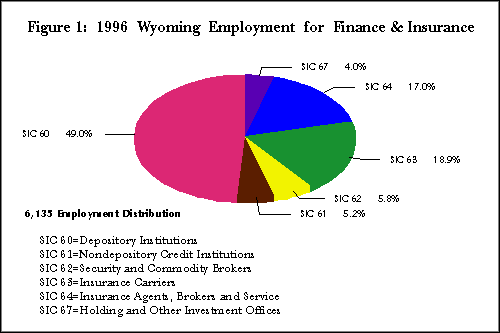 Figure 2 shows the average weekly wages for Finance & Insurance.
Each industry pays more than $440, the statewide average weekly wage
in 1996. Holding and Other Investment Offices (SIC 67) and Security
and Commodity Brokers (SIC 62), two of the smaller industries (in
terms of employment) pay the highest wages, while the larger industries
(SIC 60 and 64) pay the lowest wages in the group. Perhaps the high
wages in Finance can be partially attributed to high productivity from
computer use. A 1993 survey done by the Census Bureau showed that more
employees in Finance use a computer at work than in any other
industry3.
Figure 2 shows the average weekly wages for Finance & Insurance.
Each industry pays more than $440, the statewide average weekly wage
in 1996. Holding and Other Investment Offices (SIC 67) and Security
and Commodity Brokers (SIC 62), two of the smaller industries (in
terms of employment) pay the highest wages, while the larger industries
(SIC 60 and 64) pay the lowest wages in the group. Perhaps the high
wages in Finance can be partially attributed to high productivity from
computer use. A 1993 survey done by the Census Bureau showed that more
employees in Finance use a computer at work than in any other
industry3.
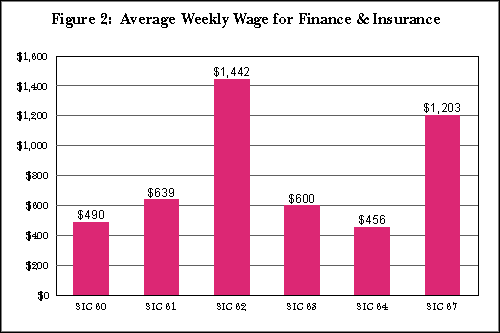
Depository Institutions
Depository Institutions (SIC 60) includes commercial banks, thrifts or
savings & loans, and credit unions. Employment in this category
lost 639 people from 1989 to 1996, falling from 3,646 to 3,007 (-17.5%).
At the same time, deposits in banks grew by over four billion dollars
(see Figure 3). In 1989, banks in Wyoming held $3.8 billion in
deposits, but by 1996 they held $7.0 billion. What can explain the
decreasing employment? At the end of 1989, Wyoming had 80
commercial banks and savings institutions, but this fell to 58 in
1994. It appears that many workers lost their jobs as depository
institutions failed and consolidated. The number of depository
institutions reached a peak in 1984 and then fell dramatically.
Employment in SIC 60 shows a positive correlation with the number
of depository institutions.
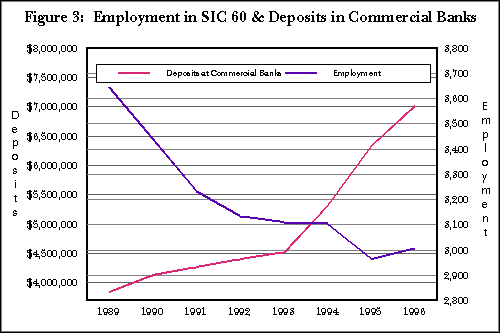
Figure 4 shows employment in Depository Institutions (SIC 60) and
the number of FDIC insured commercial banks and savings institutions
in Wyoming. Both the number of depository institutions and employees
fell from 1989 to 1994 and then increased slightly from 1995 to 1996.
Employment in this industry is expected to continue to grow slowly (see
“Projections” below). Trends in
depository institutions at the national level show a similar pattern
to Wyoming. During the period 1989-1996, the United States lost
254,800 jobs in depository institutions. While still a significant
decrease in percentage terms (11.2%), it is a smaller loss than the
depository institutions industry experienced in Wyoming.
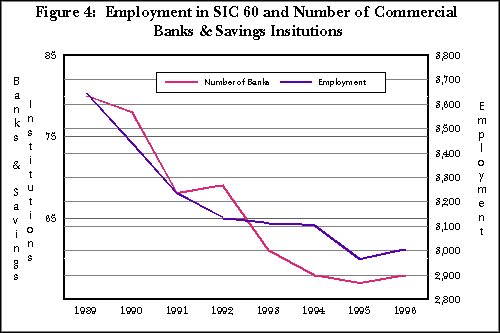 There appear to be three main reasons for declining employment in
depository institutions: failures, mergers and automation. While
an in-depth discussion of these issues is beyond the scope of this
article, a brief outline will help the reader better understand some
of the changes taking place in this industry.
There appear to be three main reasons for declining employment in
depository institutions: failures, mergers and automation. While
an in-depth discussion of these issues is beyond the scope of this
article, a brief outline will help the reader better understand some
of the changes taking place in this industry.
Between 1980 and 1994, 20 banks and seven FDIC insured savings and
loans failed in Wyoming. Table 2 lists them in
chronological order of failure. Glancing over Table 2 reveals that
depository institutions failed in all of Wyoming’s major cities
and several of its small towns. The banks had $375 million in
assets4. While no single factor can
explain why 17 percent of Wyoming’s banks failed, the recession
caused by the decrease in energy prices appears to be partially
responsible. However, as noted in the FDIC Banking Review, it
wasn’t just the severe recession, it was the rapid growth
leading up to it that caused banks to overextend themselves. Thus,
banks failed in Wyoming because of boom and bust cycles.
Table 2: Failed Savings Institutions and
Commercial Banks in Wyoming
| Year
|
Savings Institution
|
Location
|
| |
| 1986
|
Guaranty Federal Bank Federal
Savings Bank |
Casper
|
| 1988
|
Rocky Mountain Federal
Savings & Loan Association |
Cheyenne
|
| 1988
|
United Savings Bank of
Wyoming |
Cheyenne
|
| 1989
|
First Federal Savings
Bank |
Diamondville
|
| 1990
|
Provident Savings Association
|
Casper
|
| 1990
|
Sweetwater Federal Savings
& Loan Association |
Rock Springs
|
| 1991 |
Westland Federal Savings &
Loan Association |
Rawlins
|
| |
| Year
|
Commercial Bank
|
Location
|
| |
| 1983
|
Western National Bank of
Lovell |
Lovell
|
| 1984
|
Western National Bank of
Casper |
Casper
|
| 1984
|
State Bank of Mills
|
Mills
|
| 1985
|
Citizens State
Bank |
Edgerton
|
| 1985
|
American National Bank of
Riverton |
Riverton
|
| 1985
|
First National Bank of
Glenrock |
Glenrock
|
| 1985
|
Saratoga State
Bank |
Saratoga
|
| 1985
|
Yellowstone State
Bank |
Lander
|
| 1986
|
American Bank of
Casper |
Casper
|
| 1986
|
First National Bank of
Douglas |
Douglas
|
| 1986 |
Security Bank of
Glenrock |
Glenrock
|
| 1986
|
The First National Bank
of Sheridan |
Sheridan
|
| 1986
|
Medicine Bow State
Bank |
Medicine Bow
|
| 1986
|
American National Bank
of Eastridge |
Casper
|
| 1986
|
Valley State
Bank |
Baggs
|
| 1987
|
American National Bank
of Evanston |
Evanston
|
| 1987
|
Stockmen's Bank &
Trust Company |
Gillette
|
| 1987
|
American National Bank of
Afton |
Afton
|
| 1987
|
First State Bank at
Shoshoni |
Shoshoni
|
| 1988
|
Bank of
Casper |
Casper
|
Source: Federal Deposit Insurance Corporation (FDIC) Historical
Statistics on Banking.
Consolidation in the banking industry is closely related with the
deregulation and the increase in interstate branching. Wyoming lost
26 banking organizations to mergers and breakups from 1980 to
19955. Mergers reduce employment as
the combined organizations eliminate duplicated positions, often
closing branches that serve the same area.
Computer automation has allowed depository institutions to save money
by replacing tellers with automated teller machines (ATM’s). A
Bureau of Labor Statistics economist, Teresa Morisi, noted that as
employment in commercial banks has fallen, the volume of ATM
transactions has increased year after year6
. Her article also identified telephone transactions, direct
deposits and point-of-sale transactions as technologies that allow
depository institutions to serve more customers with fewer
employees.
Insurance
The Insurance industry contains two groups: Insurance Carriers
(SIC 63), who underwrite insurance, and Insurance Agents and Brokers
(SIC 64) who sell insurance, service insurance claims and offer
other insurance-related services. In sharp contrast to depository
institutions, employment in Insurance (the sum of SIC 63 and 64) grew
rapidly between 1989 and 1996. It added 664 jobs, giving it a growth
rate of 43 percent, more than twice the rate of increase in all UI
covered jobs (15.5%). The increase is split between SIC 63 and SIC
64. Some of this growth came from new firms relocating to Wyoming,
while other jobs have resulted from existing firms adding employees
to better serve a growing population and an expanding economy.
Projections
Figure 5 shows employment projections by quarter for 1997 and 1998
for Depository Institutions (SIC 60) and Insurance (SIC 63 and 64).
Employment in Depository Institutions is expected to grow 1.9 percent
or 60 jobs over the two-year period. In other words, it will continue
its pattern of slow growth that began in 1995. Insurance will grow
faster over the same period adding 179 jobs for an 8.1 percent
growth rate.
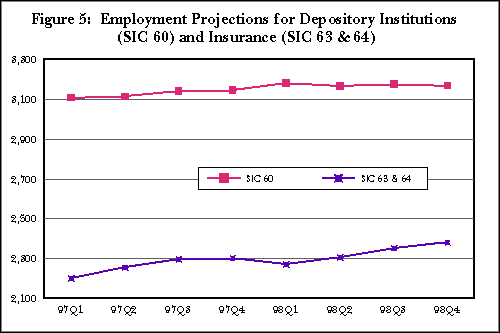
Conclusion
The Finance and Insurance industries only employ a small fraction
of workers in Wyoming, but they pay high wages. Despite growth in
deposits, failures, mergers and automation caused the number of
depository institution employees to fall dramatically in the late
1980’s and early 1990’s. During the same period, Insurance
enjoyed rapid employment growth. Current projections are for slow
growth in depository institutions, and more moderate growth in the
Insurance industry as Wyoming moves toward the 21st century.
David Bullard is an Economist, specializing in Local Area
Unemployment Statistics (LAUS) with Research & Planning.
1 Steering Committee for Business Development,
Vision for a New Economic Future, November 1997.
2 The Real Estate industry (SIC 65) was the subject
of a previous article: Mike Evans, "
Wyoming Construction and Real
Estate Industries: Where Have We Been and Where Are We
Going?" Trends, July 1997.
3 US Census
Bureau, Use of Computers at Home, School, and Work by
Persons 18 Years and Older, October 1993.
4 “The Banking Crises of the 1980’s and
Early 1990’s Summary and Implications,”
FDIC Banking
Review, Volume 11, Number 1 (1998).
5 Keeton, William R., “Banking
Consolidation in Tenth District States,”
Federal Reserve
Bank of Kansas City Economic Review, Volume 81, Number
2 (Second Quarter 1996).
6 Morisi, Teresa L., “Commercial Banking
Transformed by Computer Technology,”
Monthly Labor
Review, Volume 119, Number 8 (August 1996).
This article was published in the
Wyoming Labor Force Trends
August 1998 issue.
|